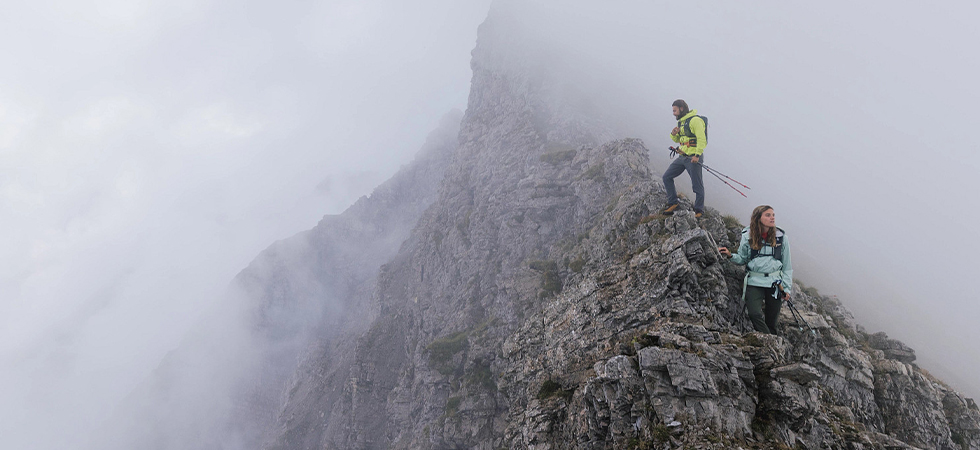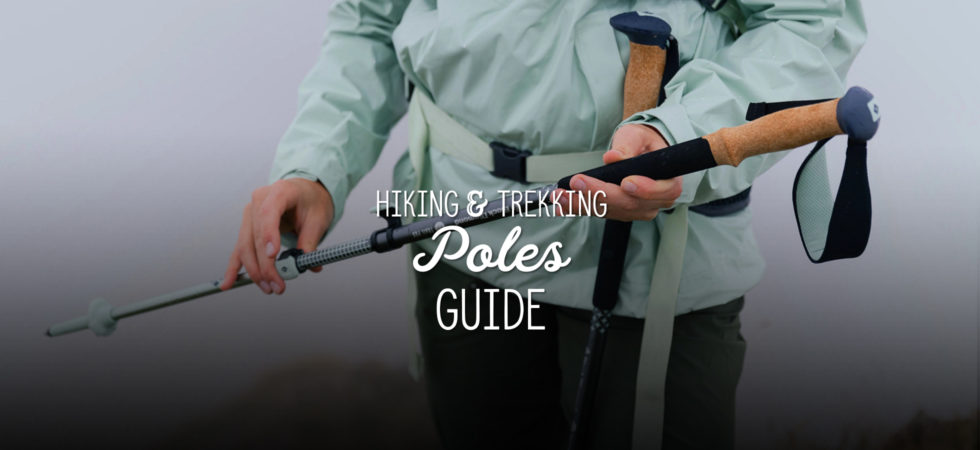More and more people swear by hiking poles when hiking, trail running and also on longer trekking tours. They support you not only during the ascent and descent, but are also a great help in between to overcome obstacles and difficult passages easier. Have you ever thought about buying hiking poles, but you are not sure if you really need them? In this article you will first learn about the advantages and disadvantages of hiking poles. We will also explain how the different products differ and give you tips on what to look for when buying your poles.

HIKING POLES, YES OR NO?
Basically, it makes sense and is recommended to have poles with you when hiking, even if they are not always used. They are especially helpful if the terrain is rough and steep or if you have to carry a heavy backpack. However, it’s also important that you don’t use them all the time. Why this is the case quickly becomes clear from the following advantages and disadvantages:
Advantage: The body is relieved
When walking uphill, the load is distributed more efficiently between your legs and arms. You can push yourself up on the hiking poles and thus also train your upper body during ascents. The leg muscles, in turn, are somewhat relieved, do not tire as quickly and you benefit from a longer endurance. Even with heavy luggage on your back, trekking poles help reduce the strain on your shoulders, torso and hips. The constant movement of the arms also prevents shoulder pain. When walking downhill, on the other hand, the knees are spared – the momentum is absorbed by the poles and the joints have to absorb significantly less weight.
To ensure that the body is actually relieved, it is important to adjust the pole length according to your height. On the straight, you should keep an angle of about 90 degrees between the upper and lower arm. On steeper sections, you must shorten the length of the poles accordingly so that your arms are not overstretched. When descending, you must adjust the poles longer depending on the slope – if the poles touch the ground too early, the shoulders will only be additionally stressed.

Advantage: Better balance and more safety
Especially in difficult places such as river crossings, exposed slopes and particularly narrow paths, hiking poles support balance and thus provide more safety. They can also be an advantage on wet, slippery surfaces or scree. Possible falls and slips can also still be cushioned with trekking poles in most cases. For this reason, they often give hikers an additional psychological security. Indirectly, hiking and trekking poles therefore prevent accidents and often prevent injuries.
Disadvantage: Use poles only in moderation
The disadvantage of uninterrupted use of poles is that the parts that are being supported are also being diminished at the same time. Surefootedness and balance decrease as the stabilization muscles are trained less and the body relies more and more on the poles. Without the poles it can therefore happen that you are suddenly more insecure than before. That’s why you should leave your hiking poles at home every now and then or strap them to your backpack for sections. Especially inexperienced hikers or mountaineers should do without poles in the beginning to get a better feeling for the terrain.

WHAT YOU SHOULD CONSIDER WHEN BUYING TREKKING POLES
Now that you know the pros and cons of trekking poles, you should still know what different features to look for before buying. Here we have summarized the most important aspects about material, grip, system, pole tips and suspension for you:
Material
Basically, there are two materials: carbon and aluminum.
The majority of hiking and trekking poles are made of sturdy aluminum. This material has the property to react flexibly to resistance and is therefore difficult to break.
This is different with the much more expensive carbon poles. These are a lot lighter than aluminum poles, but very stiff and therefore more prone to breakage. If you get stuck on stones or roots, micro-cracks can quickly form, which sooner or later lead to the fact that the stick breaks.
For this reason, in addition to poles made of pure aluminum or carbon, there are also poles that consist of a combination of both materials. Here, carbon is processed in the upper part of the pole to guarantee lightness, while the lower section is made of aluminum and makes the pole more resistant.
Handle
There are also significant differences in the handles depending on the price: poles from the cheaper price segment are usually equipped with handles made of plastic, rubber or imitation cork. The disadvantage of these materials is that your hands quickly start to sweat and blisters can even form on long tours. In the mid-price segment, on the other hand, foam is increasingly used, which is softer and more breathable. High-priced poles usually have cork handles, as these are the most comfortable in the hand. In addition, some handles are slightly tilted forward to relieve the wrist or extended to be able to quickly and easily change grip on changing slopes.
In addition, hand straps are attached to all models. These provide the optimal connection and power transmission between hiker and pole.

System
Basically, we can distinguish two different systems that allow to adjust the pole height: Telescopic and folding poles.
Telescopic poles can be equipped with either a speedlock system or a screw system. In the case of the former, the height can be easily and safely adjusted by clamping and it therefore also enjoys great popularity. The Speedlock system makes the pole a lot more stable than with the somewhat outdated screw system, which is hardly ever used anymore. Here, the individual parts of the pole are fixed by turning. This system is not only more complex, but also harder to use and more prone to defects.
Folding poles are designed for lightness and therefore usually have a high carbon content. Here, clamps or screws are not used, thus saving quite a bit of weight. Folding poles are especially popular with trail runners because they have a smaller pack size and can therefore be easily stowed in trail running backpacks.
Pole tip and plate
The pole tip provides the necessary grip in challenging terrain. If you are more likely to be walking on hard ground, you can pull an additional rubber buffer over the pole tip. This creates a softer attachment, which is recommended for Nordic walking, for example.
The plates are rather small on trekking poles and ensure that you don’t sink into the mud on rough terrain. If you want to go on tours in winter, you should use special snow plates. These are significantly larger in comparison and are also used for freeriding and ski touring. For trail running, the plates are very small to keep the weight of the poles as low as possible. Usually, different plate sizes are included and you can easily switch between them.

Suspension
Meanwhile, there are hiking poles with anti-shock system. A built-in spring provides perfect damping. Shocks are simply absorbed to provide more comfort on your tour. But be careful: poles with damping are only recommended on hard surfaces, i.e. on asphalt roads or paved forest paths. In steep and yielding terrain, however, they are a disadvantage, because the walking stick jumps and yields due to the suspension. As a result, it does not provide enough safety. In addition, the anti-shock system makes the pole heavier.
REPAIRING YOUR POLES
Do you ever have problems with your pole? Our Sport Conrad stores in Garmisch-Partenkirchen, Penzberg and Wielenbach are equipped with a repair department for LEKI products. From grips to plates to tips: Here, used and worn parts can be replaced or repaired directly on site without having to send the product to the manufacturer LEKI. You can have your Leki poles checked and repaired easily and usually free of charge. This not only saves you money, but also does something good for the environment, because the longer the life of a product, the more natural resources are conserved.
On the Sport Conrad website you will find a wide selection of hiking poles for your next trekking tour – no matter what color, brand or size you prefer. So nothing stands in the way of your next hike.
Interested in more hiking content? Check out our other blogposts:
LEKI Service-Center for you in our store!
Hike with the righ equipment: Hiking and Trekking Essentials
Find out the truth behind these 7 hiking myths
Choosing the right hiking boot: All you need to know
How LEKI turned poles into a must-have in trail running
Tips and Tricks: Hiking with Kids
Photos: Leki, Black Diamond













